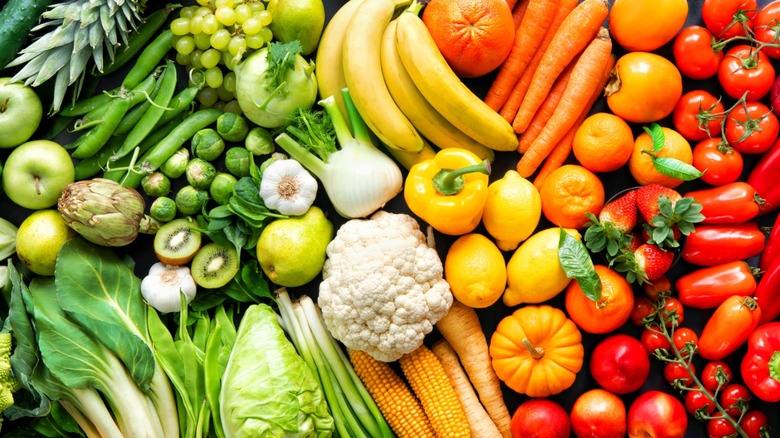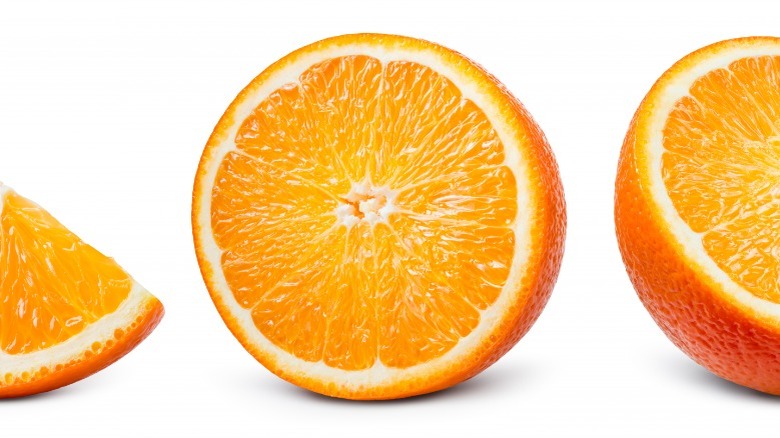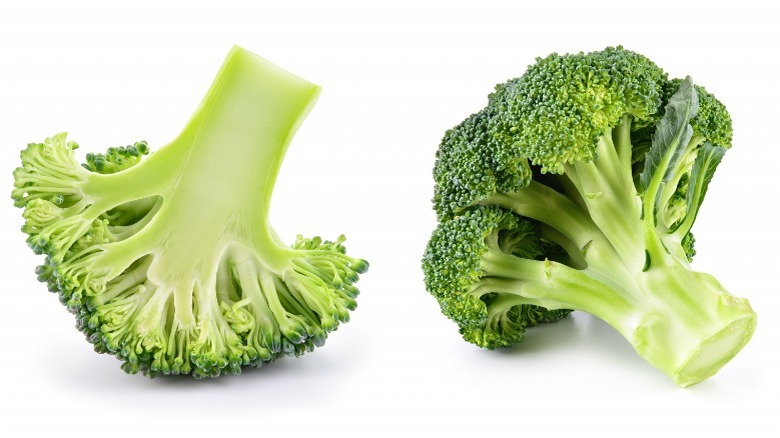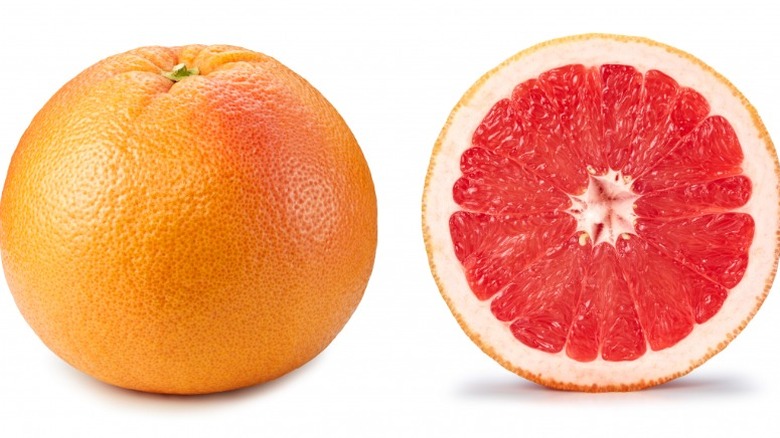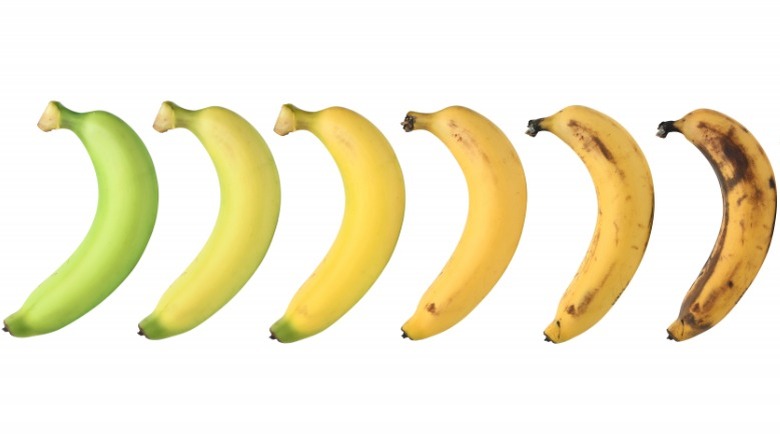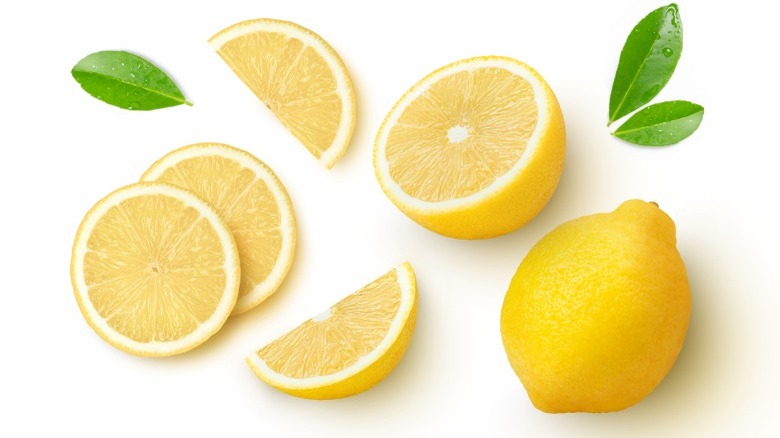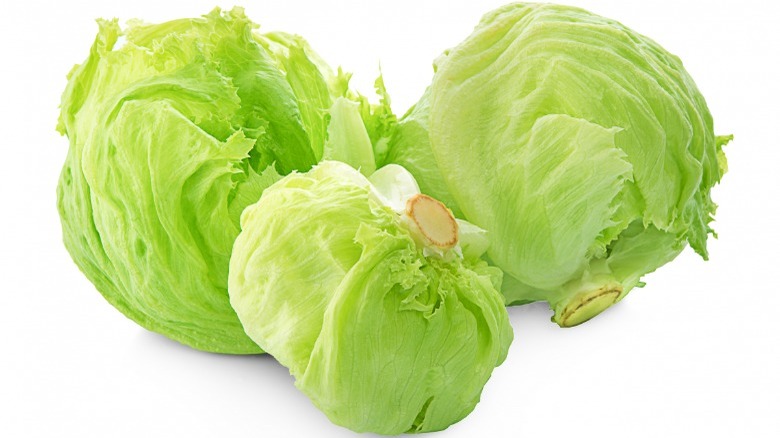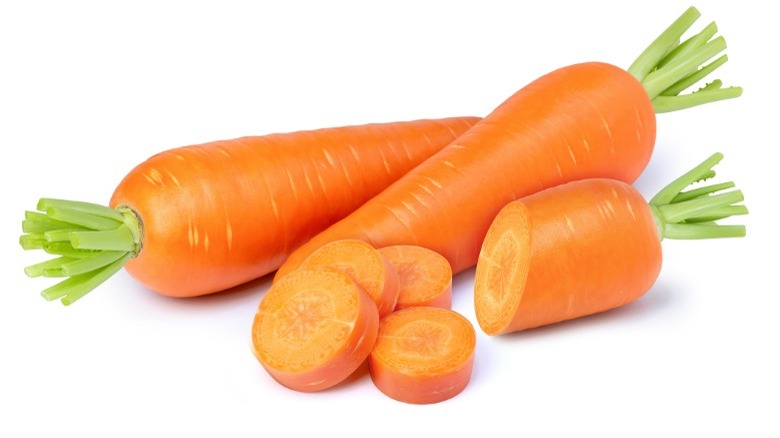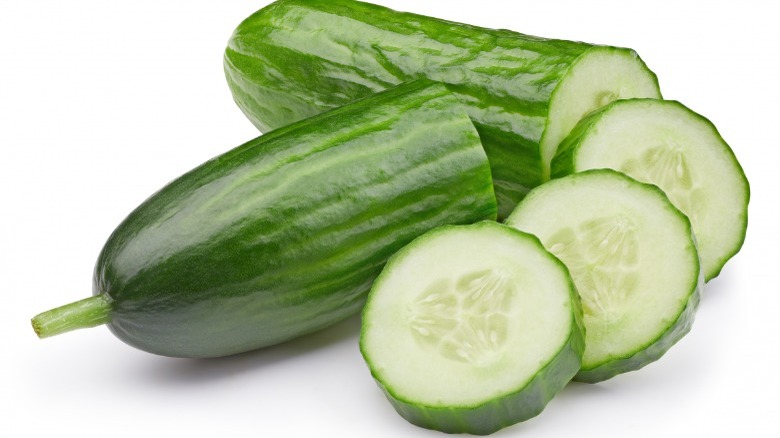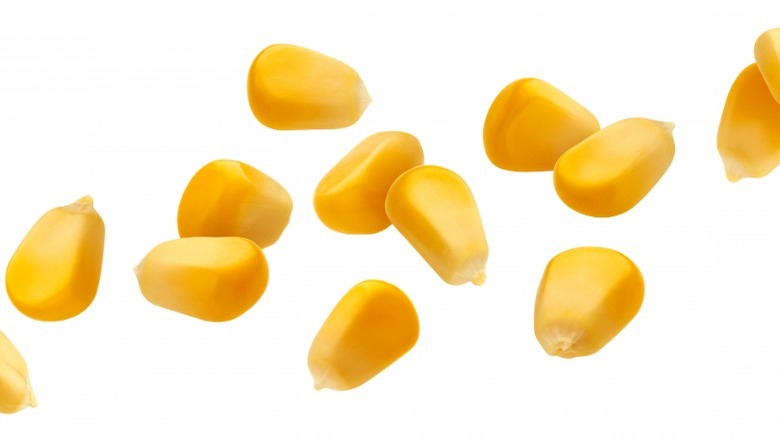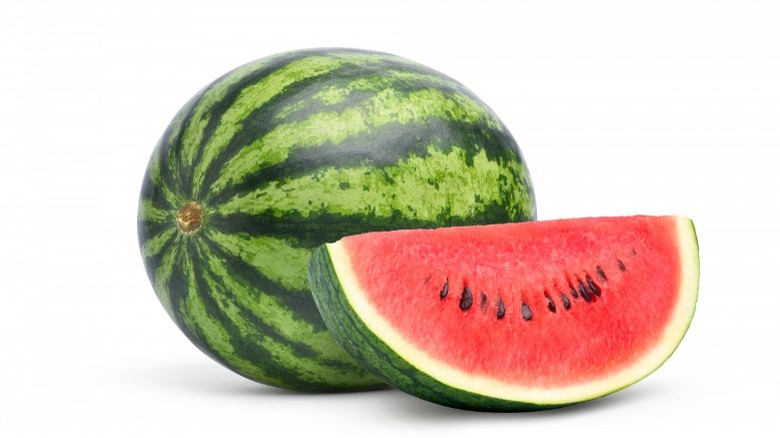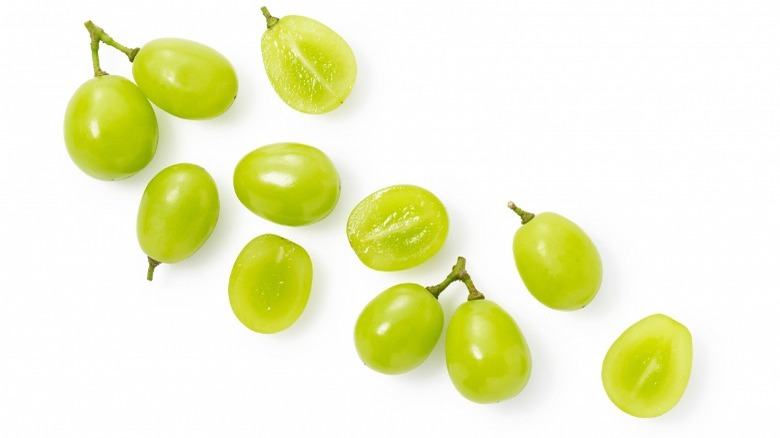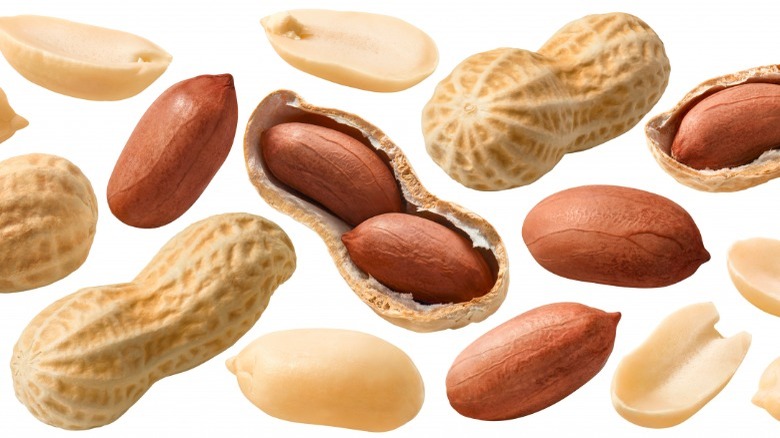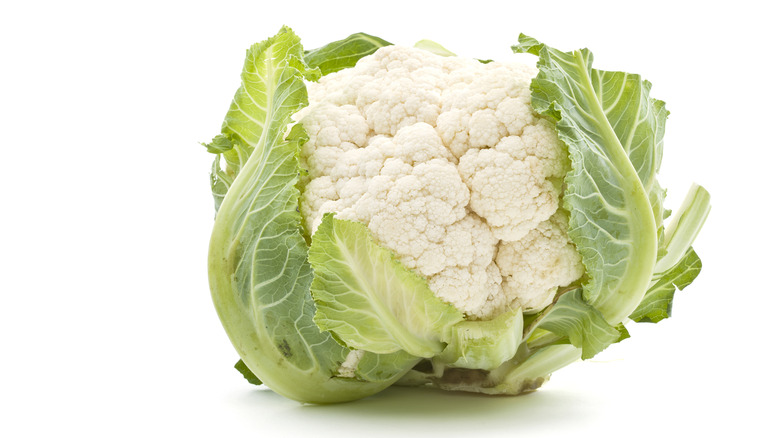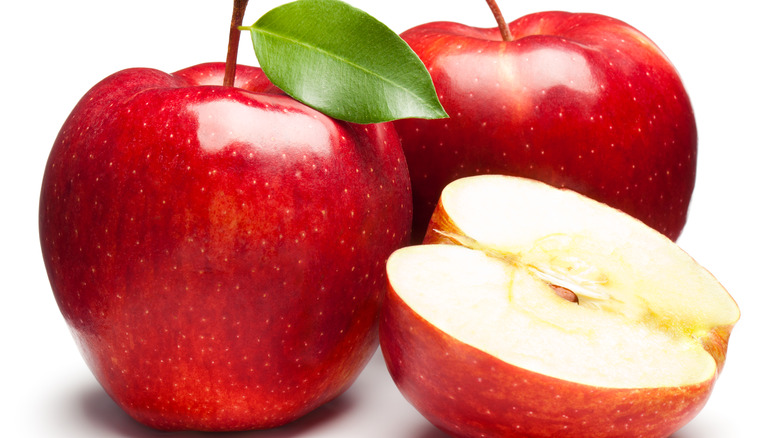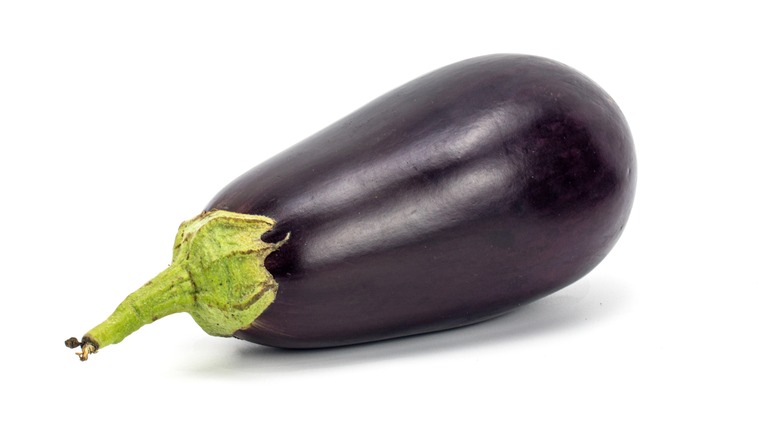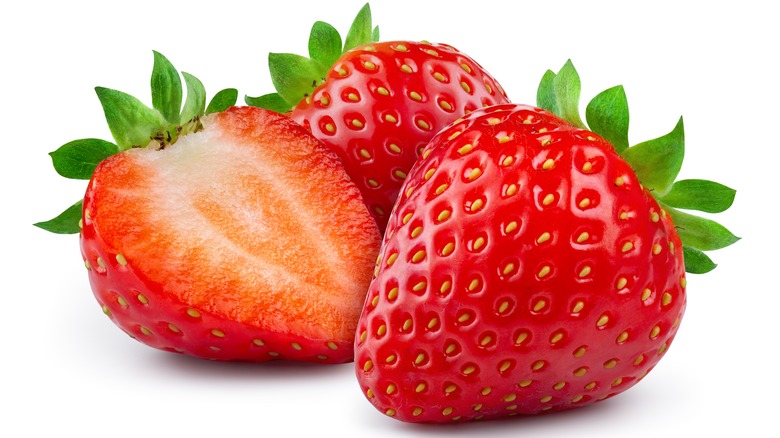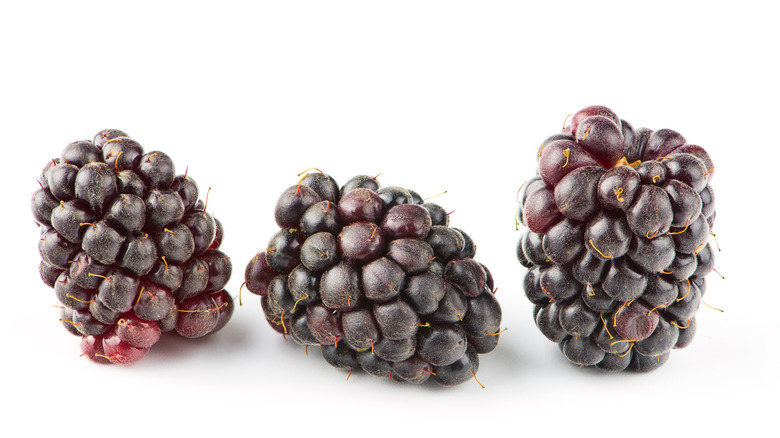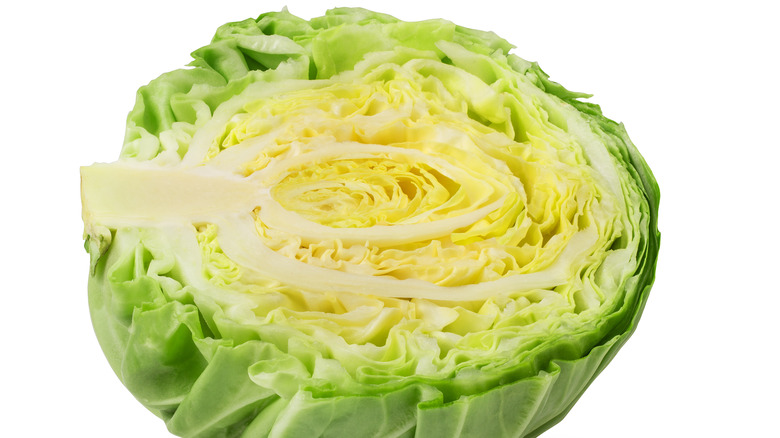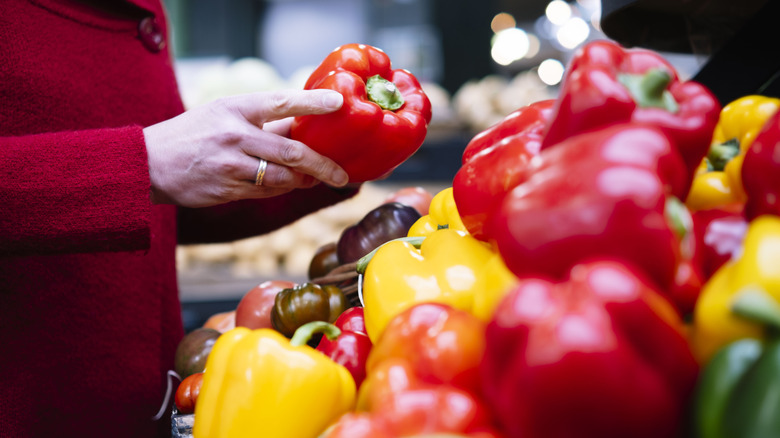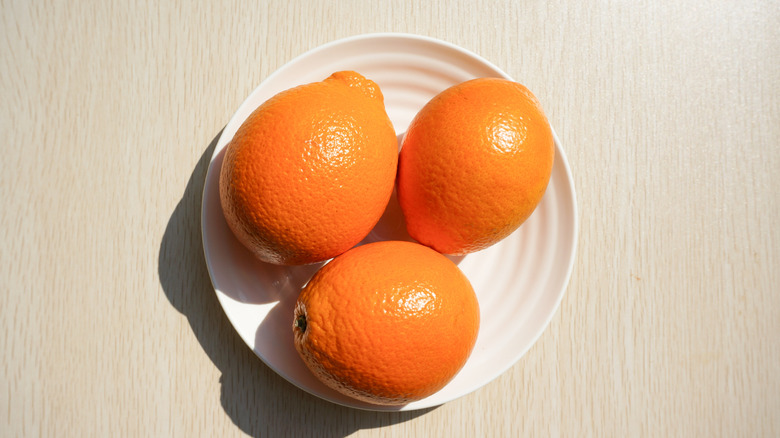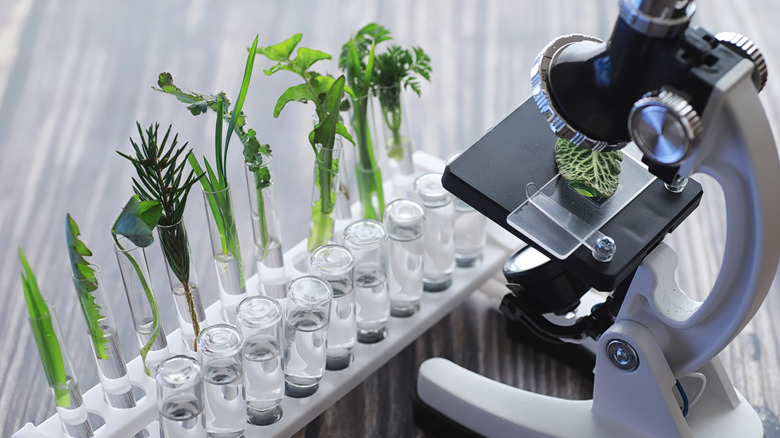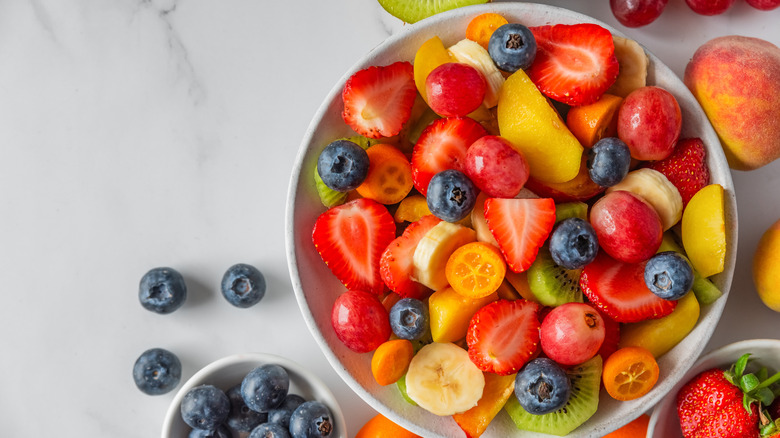23 Common Fruits And Vegetables That Are Actually Man-Made
When you bite into a juicy watermelon slice or munch on a handful of seedless grapes, it's easy to assume that these fruits have always existed in their current form. But the truth is that many of our favorite fruits and vegetables have been selectively bred, hybridized, and genetically modified by humans over thousands of years. From the earliest days of agriculture to modern genetic engineering techniques, people have been tinkering with plants to make them tastier, sturdier, and easier to grow.
Get ready to explore the fascinating history of some of the most common produce items and uncover the surprising ways that humans have shaped their evolution. We'll learn how wild citrus fruits were transformed into the oranges, lemons, and grapefruit we know today and how an ancient grass was domesticated and bred into hundreds of different varieties of corn. We'll also discover the origin stories of bananas, cucumbers, and iceberg lettuce, and take a closer look at how a combination of pure chance, nature's mysterious mutations, and human ingenuity over time have given rise to some truly unique edible plants. So whether you're a fan of heirloom tomatoes or seedless watermelon, this exploration of the man-made produce we encounter on a regular basis will surely shine some light on the origin stories of your favorite fruits and veggies.
Oranges
These ubiquitous citrus fruits have been around for so long it's hard to imagine humanity without them. Despite the fact that they've been around for millennia, today's sweet oranges didn't actually exist in nature and had to be brought into existence by humans. The origin of oranges is often attributed to ancient China, where their first written mention, dated 314 B.C., was discovered. Later, they were introduced to Europe by the Moors during their rule in Spain in the 8th century and brought to the Americas by Spanish explorers in the 15th century.
The wild orange was bitter and sour (and is still known under these names), so it wasn't involved in developing the new, sweet species. Instead, they cross-pollinated pomelo and mandarin. One is a large, yellow, thick-skinned, sweet citrus, and the other is a smaller, orange-colored bitter fruit. Both are believed to be original non-hybrid citrus species that became the ancestors of all subsequent citrus fruits. Over time, various types of oranges were developed through crossbreeding and selection. Today, the ever-growing orange family tree has hundreds of varieties, including peculiarly shaped sweet and acidic Sumo oranges and seedless Cara Cara oranges that pack a sweet punch.
Broccoli
This nutritious plant was enjoyed in Italy long before it became a mainstay anywhere else. Apicius, the famous ancient Roman recipe collection, and writings of Pliny the Elder both mention a vegetable fitting broccoli's description. But it's not like they accidentally found it in the wild. In fact, broccoli is a man-made descendant of the wild mustard plant, Brassica oleracea. Its ancestors were bitter and had small, undeveloped heads, and it took many generations of crossbreeding and selection to create the larger, more tender heads we know and love today. Thus, America's favorite vegetable (and its various cousins such as cauliflower, Brussels sprouts, and kale, all coming from Brassica oleracea) wouldn't exist if it wasn't for the agricultural efforts of ancient Etruscans.
But the story of broccoli doesn't end there. In recent years, a new hybrid of broccoli has emerged called broccolini, a cross between broccoli and Chinese kale, or gai lan. The difference between broccolini and its namesake parent plant is both in appearance and taste. The former owes its long, tender stalks, small, delicate florets, and a sweeter, more delicate flavor to gai lan. Another modern-day broccoli hybrid is broccoflower — a chartreuse cross between broccoli and cauliflower that is sometimes confused with romanesco.
Tomatoes
Present-day tomatoes have come a long way from their humble natural origins to their current status as one of the most beloved fruits in the world. Previously, it was believed that about 7,000 years ago, the people in South America domesticated Solanum pimpinellifolium —a wild tomato plant with tiny fruit — until it reached the size of a cherry, and that modern tomatoes are a direct descendant of this intermediate semi-domesticated breed. However, a 2020 study revealed that it existed in the area as far back as 80,000 years, which predates human crop cultivation. It is still unclear how this nightshade family member was able to travel northward to Mesoamerica, but once humans got to work on it, it started to take its modern shape.
It wasn't until the 16th century that tomatoes were introduced to Europe, and even then, they were slow to catch on. In fact, for many years, tomatoes were considered ornamental rather than edible. It wasn't until the 19th century that tomatoes began to be bred specifically for their culinary value, with larger, juicier varieties being developed through crossbreeding and selection. Today, there are hundreds of different tomato varieties, ranging from small cherry tomatoes to large beefsteak tomatoes. And with new varieties and uses still being developed, it's clear that the tomato's journey is far from over.
Grapefruits
Compared to lemons and oranges, these thick-skinned fruits are a relatively recent addition to the citrus family, having been first discovered in the Caribbean around 300 years ago. Moreover, grapefruits are actually a hybrid of two other citrus fruits — pomelo and sweet orange (the latter itself being a hybrid of pomelo and mandarin). It is believed that grapefruits were first created by chance due to the Europeans' casual planting of citrus trees around the West Indies. Citrus trees are naturally prone to hybridization, so when pomelos and sweet oranges were planted next to each other, and their seeds crossed, it resulted in a new fruit.
The first recorded mention of grapefruit was in Jamaica in the early 18th century, where it was referred to as the "forbidden fruit." But it wasn't until Count Odette Philippe cultivated the fruit in Florida and established the first post-colonial commercial grove in the 1820s that they gained commercial importance. Once a delicacy of the rich, grapefruits were cultivated and bred over time for their sweeter, less bitter flavor. Today there are many different varieties of grapefruit available, from pink and red to white and yellow.
Bananas
While there are hundreds of types of bananas, all different in size, color, texture, and flavor, they all have evolved from their wild ancestors under human domestication. The bananas we know today are descendants of two wild progenitor species — Musa acuminata, which had a meaty but unappealing flesh, and Musa balbisiana, which had too many seeds for it to be enjoyable, per Plant Gene. While the sweet, seedless, yellow banana is believed to have appeared from random mutation, without human intervention, it wouldn't have transformed from a wild foodstuff into a staple. Moreover, the modern banana can't reproduce without human help because its appealing lack of seeds directly results from cloning.
Unfortunately, that's exactly why the banana you're likely familiar with could become extinct. The Cavendish banana, which is currently the most widely grown banana variety in the world, is threatened by a new strain of the same fungal disease that wiped out the Gros Michel banana (the Cavendish of the early 20th century). And because most Cavendish bananas are genetically identical clones, there is a high risk of the disease spreading rapidly and decimating banana crops worldwide. Therefore, it's possible that we could see a shift towards other banana cultivars that are more resistant to disease or even some new hybrid varieties. But for now, let's savor and appreciate the humble Cavendish banana while we still can.
Lemons
Life didn't necessarily give humans lemons, so they had to make lemons themselves — or at least build upon the natural hybridization of protogenic citrus plants. Today, lemons are a staple around the world, but their origin story is a bit of a mystery. While it is believed that lemons are a mix of two other citrus fruits — the citron and the bitter orange — there is some debate over whether lemons are a man-made fruit or if they occur naturally.
Citrons, naturally, are quite different from lemons — they are large, thick-skinned citrus fruits that are native to Southeast Asia and considered to be one of nature's original citrus fruits. In contrast, bitter oranges are a hybrid of pomelo and mandarins, known for their tart, bitter flavor. It is believed that lemons were first created by chance when citrons and bitter oranges were planted next to each other and their seeds crossed, resulting in a new hybrid fruit.
And then there are Meyer lemons, which are a slightly different story. Meyer lemons are believed to be a hybrid of lemon and mandarin or sweet orange, which is why they aren't considered true lemons. They originated and China and were treated as decorative plants, but Frank Meyer, a United States Department of Agriculture worker, brought them back to the U.S. in the early 20th century, where they are still celebrated for their unique floral and sweet flavor.
Iceberg lettuce
One of America's most consumed green vegetables with the most scandalous reputation wouldn't exist if it wasn't for Atlee Burpee & Co., an American mail-order seed company. Founded in the late 19th century, the company focused on developing new vegetable varieties better suited to commercial farming and shipping. In 1894, its founder, W. Atlee Burpee, introduced a revolutionary lettuce variety that was able to maintain its fresh crispness longer than other greens. But what gave it its name and helped it spread across the country, introducing salads to homes and restaurants, has everything to do with its transportation.
A farmer named Bruce Church played a significant role in popularizing lettuce, particularly iceberg lettuce, in the United States. Church's early success in the lettuce industry came from his idea to pack and ship lettuce in ice, which he did with a field of head lettuce in 1926 to great commercial success. According to one company legend, the term "iceberg lettuce" originated from the excitement of children in Maine, who would exclaim that "The icebergs are coming!" when the lettuce shipments arrived. Today, iceberg lettuce remains a staple of American cuisine, and its popularity is due in no small part to the efforts of people like W. Atlee Burpee and Bruce Church.
Orange carrots
Prior to the domestication of its edible root, carrots were cultivated for their leaves and seeds, which were used in medicine. The root of the plant was thin, woody, and bitter, unlike the plump, sweet carrots we know today. Over time, selective breeding by farmers in Europe and Asia resulted in the development of larger, more palatable roots. But the carrots of the Middle Ages were largely white, yellow, and purple and had a sweet rival by the name of parsnip.
That changed when the 17th-century Dutch farmers began cultivating orange carrots. Although orange carrots existed naturally, it was the Dutch who turned them into a mainstay. The orange carrot quickly gained popularity in Europe and eventually became the standard variety. In the 19th century, French breeders developed the modern "Nantes" variety, named after the city that had ideal growing conditions for these cylindrical-shaped, smooth-skinned, and sweet carrots. This variety became the basis for most modern carrot breeding programs.
Ironically, today, the old-fashioned heirloom purple, white, and yellow carrot varieties are back in fashion, prized for their unique look and flavor, as well as their nutritional content. Despite their differences, all modern carrots share a common ancestor in the wild carrot, which still grows throughout Europe and Asia.
Cucumbers
If you've ever bitten into a fresh, crunchy cucumber only to be forced to do a spit take right away, you might get the idea of what the original wild cucumbers tasted like before domestication and selective breeding. The cucumbers that humans encountered thousands of years ago had a high concentration of a bitter-tasting, toxic compound called cucurbitacin, which made them dangerous to consume. Over time, cucumbers were bred to minimize bitterness and toxicity. However, by the time ancient Greeks and Romans got their hands on them, they were still too bitter to consume without cooking.
As cultivation progressed, more kinds of palatable cucumbers appeared. Victorian-era households could partake in various cultivars, including large slicing cucumbers, thin-skinned straight cucumbers, and burpless varieties. They might have even partaken in a variety that's often mistaken for a tiny watermelon: cucamelon. Despite its name, it is not a cross between a cucumber and a watermelon but rather a member of the cucumber family that bears a visual resemblance to the striped green fruit. The cucamelon is native to Mexico and Central America, where it has been cultivated for centuries. One other unusual cucumber variety is the lemon cucumber, which appeared in the late 1800s as a result of natural selection. Despite the visual resemblance to its namesake citrus fruit, it is also a true cucumber.
Corn
Corn, also known as maize, is a major food staple around the world, but it was originally a wild grass called teosinte, which doesn't resemble present-day corn visually or nutritionally but has much of the same DNA. The transformation from teosinte barely edible cobs to modern corn took place over thousands of years through the process of domestication and selective breeding by indigenous peoples in Mesoamerica.
Teosinte is a much smaller plant with small ears that contain only a few kernels. Over time, indigenous farmers selectively bred teosinte plants with desirable traits, such as larger ears and more kernels, resulting in the development of what we now know as corn. Recent findings also show that the grain spread around South America before its domestication in the home region was complete. This means that even though modern corn varieties share a common ancestor in teosinte, its evolution path was more dispersed than previously believed.
Today, there are countless varieties of corn — some are used primarily for food, while others are used for animal feed, ethanol production, or industrial purposes. One example of an unusual hybrid variety is glass gem corn, which has translucent kernels that resemble brightly colored glass beads. Another interesting variety is Black Aztec, which is a dark purple-black color and is often used in traditional Mexican dishes.
Watermelons
The ancient truth about the origins of watermelons is that the fruit we know today is far from the original. Wild watermelons were about two inches big, bitter, packed with hard seeds, and lacking lycopene — the compound responsible for the red flesh tint of modern fruit. Over thousands of years, humans cultivated watermelons to become larger, sweeter, and with fewer seeds. Ancient Egyptians and other civilizations in the Middle East and Mediterranean region are believed to have been some of the first to cultivate watermelons for their sweet, juicy flesh. In the 17th century, watermelons were brought to America and continued to be selectively bred for desirable traits.
Today, there are countless varieties of watermelons available around the world, ranging from small, seedless, mini watermelons to large, oblong-shaped watermelons with dark green rinds and bright red flesh. Most varieties are reasonably priced when in season; however, the rarest watermelon could cost you thousands of dollars. The Densuke watermelon, grown only on the island of Hokkaido, Japan, has a hard black rind and sweet, crisp flesh. Because only a limited number are grown each year, with strict quality control measures in place, Densuke watermelons can fetch prices upwards of $6,000 at auction. But for most of us, a juicy slice of any watermelon on a hot day is already priceless.
Seedless grapes
While grapes have been a part of the human diet for many centuries, seedless grapes are a relatively new invention. The wild origins of seedless grapes are not well-documented, and it is believed that they were initially developed through natural mutations. However, in the late 19th century, horticulturists in California began experimenting with breeding seedless grapes by crossing different cultivars. The goal was to produce grapes that were larger, sweeter, and easier to eat than their wild counterparts. The first commercially successful seedless grape was the Thompson Seedless grape, which was introduced in the early 20th century. This grape was a hybrid of two different grape varieties and was initially called the Sultana grape. It was renamed the Thompson Seedless grape after William Thompson, a viticulturist who played a significant role in its development and promotion.
Today, there are many different types of seedless grapes available, each with its own unique flavor and characteristics. A recent addition to the family, cotton candy grapes, whose flavor lives up to their name, were an instant hit after being introduced in 2011. Other popular seedless grape varieties include the Flame Seedless, the Crimson Seedless, and the Red Globe. And if you have ever wondered why seedless grapes sometimes have seeds, that's because all grapes do. The seeds in the "seedless" varieties are just small, soft, and underdeveloped, which makes them barely noticeable.
Peanuts
Peanuts, also known as groundnuts, originated in South America and were initially consumed by indigenous populations. Wild peanuts are small, have a hard outer shell, and can be bitter to taste. According to a study in the Journal of Advanced Research, macrofossils show peanuts existed in Peru at least 8,500 years ago and likely evolved began developing 1,500 years before that. Modern research shows that human-bred peanuts have double the number of chromosomes compared to most other species in their genus. Despite their debated origins, a 2014 article states they are believed to have come about through a single hybridization event between two wild diploid species: Arachis duranensis and Arachis ipaensis. This resulted in an allotetraploid, or a species with four sets of chromosomes, half resembling the form of one wild species and half resembling another. The wild allotetraploid then underwent domestication and improvement to become the cultivated peanut we know today.
The cultivation of peanuts spread northward from South America, eventually reaching North America in the 1700s. Peanuts quickly became popular in the United States, where they were used to feed both humans and livestock. They became so big that two different U.S. presidents dabbled in peanut farming, and the creamy paste made from them became synonymous with American food. Today, these versatile legumes are an important crop worldwide, with most of the world's peanuts coming from China.
Cauliflower
Cauliflower is in the same family as broccoli, so it's easy to see how this pale brassica could share similar origins with its green cousin. Like the other brassicas, it's believed that this vegetable originated in Asia Minor, now known as Turkey. Over the years, the vegetable was selectively bred to produce a white head with a green stalk.
There are many different varieties of cauliflower, all of which have been selected for certain desirable traits. The array of colorful cauliflower crowns, including Romanesco, are the physical expressions of these genetic selections. For example, there's orange cauliflower, also known as cheddar cauliflower, which has higher amounts of beta-carotene. This vitamin A precursor imparts a distinct orange hue to the caulilflower head. Then, there's Romanesco, which shares some similarities to broccoli and cauliflower. This human-selected variety, also called broccoflower, has a mild, sweet flavor and a distinct, bright green color. It's important to note that nature does play some part in changing the color of the cauliflower; environmental stressors like high sunlight and heat, or drought, can alter the color of brassica and its varieties.
Apples
The wild apples of centuries past bear almost no resemblance to the modern Cosmic Crisps and Granny Smiths found in grocery stores. The original apple was a distinctively sour crab apple grown in the forests of Kazakhstan and Central Asia. Over the years, farmers began to gather and cultivate these wild apples and spread them across the globe.
There have been so many strides in the selective breeding process of these apple trees in the past 200 years or so. Human intervention in apple cultivation has selected for certain desirable traits that we value in this popular fruit, including increased storage capacity and like many other fruits, a much sweeter flavor. Research from The Conversation has suggested that the modern, popular types of apples found in grocery stores are more than three times heavier and upwards of 43% less acidic than the original wild cultivars found in Kazakhstan.
One of the most interesting parts about the modern apple industry is the the use of grafting in the propagation process. If plant breeders are working with a variety that doesn't easily grow from cuttings or come to seed, like the popular McIntosh variety, they can graft it onto an existing plant. To graft a variety, the plant breeder will cut a bud from the original tree and fasten it to the body, called the rootstock, of another tree. This allows farmers to make carbon copies of an apple variety, without risking losing certain desirable traits in the process.
Eggplants
It's easy to recognize the round, globe eggplants found in the grocery store. But it took many, many years for these vegetables (which are technically considered fruits) to come to fruition. There are two primary origin stories for the eggplant — one being that it originated in present-day India, Vietnam, Laos, and China from a wild plant called Solanum incanum, also called the bitter apple.
However, other historians trace its likely origin to Northern Africa and the Mediterranean. Writings suggest that the eggplant was first domesticated in China around 59 B.C., but other than that, the records are rather sparse. But what we do know is that the Romans and the Greeks didn't really start to cultivate and grow eggplant on a large scale until the several hundred years after the original sighting of the fruit — between the 7th and 8th centuries.
The shape and deep purple color of the eggplant were the result of human intervention, too. It was believed that the original color of this fruit was either yellow or a very light purple — which bears little resemblance to modern iterations. However, you may also find variations of eggplant in different colors and shapes.
Strawberries
We can thank the French — more specifically, Antonie Nicolas Duchesne — for the creation of the modern strawberry. Compared to other man-made fruits, the strawberry is a relatively recent invention. In 1764, Duchesne crossed a male Fragaria moschata, the musky strawberry, with a female Fragaria chiloensis from Chile to produce the ripe, red fruit we know and love today. The Chilean strawberry brought considerable size to the musky strawberry — but didn't grow well outside of its balmy Chilean climate.
Down the line, this hybrid strawberry was crossed with the Virginia strawberry, Fragaria virginiana, which, as its name suggested, originated in the United States colony of Virginia. Once the hybrid and the Virginia strawberry made their way into the New World, they were yet again crossed by Charles Hovey, and the strawberries that resulted bore his name. In 1851, James Wilson was then able to cross the Hovey strawberry to produce a fruiting plant that could stand up to a variety of climates and growing conditions.
Along the way, the berry plant was again tinkered with again to increase its resistance to viral diseases like leaf scorch. Now, one trip through your local greenhouse will offer up many different strawberry varieties that have been selectively bred to produce fruit at certain types of year or bear certain desirable traits, like the unique color found in white strawberries.
Boysenberries
Boysenberries are probably not a fruit you think of too often. But, if you like blackberries in your Greek yogurt or in a pie, you're going to love boysenberries just as much. The fruit originated as a cross between loganberries, blackberries, and raspberries. The loganberry itself is a cross between the raspberry and the blackberry; think of a fruit with the considerable size of a blackberry, but with the flavor profile of a raspberry.
Depression-era Napa-valley farmer Rudolf Boysen crossed these three flowers to produce large, purple-colored fruit. Although he eventually left the ranch where he tried his hand at plant breeding, he had given some of the resulting seeds to someone, who in turn contacted the United States Department of Agriculture so that the variety could be documented.
After some years of experimentation, the new fruit, which bore Boysen's name, was brought into the modern agricultural lexicon. Boysenberries were especially taken by New Zealand's growers, who eventually shared the plant with producers in the United Kingdom and contributed to the fruit's spread across the globe.
Cabbage
The brassica family extends far and wide and includes cabbage in nearly every shape, size, and texture. The hard-head cabbage, like the type used for frying and boiling, originated in Northern Europe. Meanwhile, soft cabbage varieties, like savoy, originated in the more southern regions of the continent. The cabbage's ancestor, the wild cabbage, was believed to have been one of the first domesticated crops in the history of agriculture. Like other brassicas, farmers prized certain wild cabbage plants for the leaves forming at the base of the plant, so they had selectively bred this plant to breed more plants with similar characteristics.
Collard greens are another member of the brassica clan that's existence can be chocked up to human tinkering. It is believed that collard greens are one of the oldest members of the brassica family and originated from plants in the Mediterranean. Like other members of the family, early plant breeders found the desirable trait, the leaves, and continued breeding the plants with other types of wild mustard to produce even larger leaves.
Pluots
There are a lot of stone fruits to choose from, from nectarines and peaches to cherries and this unique hybrid: the pluot. As its name would suggest, the pluot is a cross between a plum and an apricot. Visually, it looks like a plum, and it has the plum's tasty, fleshy interior to boot. And genetically speaking, the pluot is also more like the plum than an apricot. Though, there are also trace elements of the apricot present — mainly in the fruit's honey-like flavor and apricot-tasting skin.
The pluot was first "invented" in the 1980s by a plant breeder named Floyd Zaiger. Zaiger crossed the plum with another fruit breeder, Luther Burbank's, plumcot. To express more of the plum-like traits, Zaiger then backcrossed the hybrid plant with the plum. There are several different pluot varieties that you may be able to track down. These varieties come in a number of different shapes, colors, and flavors. If you're after a flavor that's more acidic, for example, you may want to opt for a Dapple Dandy. Though, folks who are fans of a more toned-down flavor may want to go for the Flavor Queen pluot instead.
Pluots are most often grown in their home state of California, though you may be able to find them in other states that are known for their stone fruits — think Washington and Oregon. They may not be as popular as plums and apricots, but their flavor is so unique that they're worth seeking out.
Bell peppers
How many times have you walked past the shiny and bright bell peppers in your local grocery store? It's certainly a type of produce that many people take for granted. Bell peppers have a subtle sweet flavor and refreshing snap, making them the perfect base for a tasty stuffed pepper recipe or an addition to your summery pasta salad. It turns out that bell peppers, too, are man-made.
Although peppers themselves have existed in Central and Southern America for centuries, it wasn't until about the 1900s that plant breeder Gregor Carillon created the bell pepper that we see on supermarket shelves today. And interestingly enough, the bell pepper wasn't actually bred for its flavor — it was bred for its sound. The precursors to the modern bell pepper had a leftover stigma — the female part of the flower — inside of them, which poked down into the main part of the pepper and acted like the clapper in a bell — hence where the pepper's name came from. When the weather would get windy, the stigma would hit the walls of the pepper and spook nearby farm animals.
As a result, there was little interest in the fruit until Carillon came along and was able to create a "silent" pepper. It officially debuted in 1908.
Tangelos
Tangelos are the best of both worlds. They combine the traits of the tangerine and a pomelo — meaning that they have a moderate sweetness, juicy consistency, and a slight bit of tartness on the backend. These fruits are roughly the size of a baseball and typically feature a bump on one end that makes for easy peeling. It also may or may not have seeds, depending on the variety, and comes with about 10 individual sections. Since the fruit is easy to peel and portion, it's often marketed and enjoyed as a snack out of hand, though you could also use it for things like salads or for juice, too.
You can find a variety of different tangelos at the store, which will present with different colors and consistencies. The Seminole, a cross between the Bowen grapefruit and Dancy tangerine, doesn't have the jutting bump on the end; whereas the Minneola tangelo, a cross between the Duncan grapefruit and Dancy mandarin, has a looser, deeply colored flesh. Tangelos are most commonly spotted in stores and specialty fruit markets during their peak growing season, between November and March.
Almonds
Almonds are a staple ingredient for trail mix, and it turns out that we can thank plant breeding for them, too. The truth is that if you ate the bitter almonds of long ago, you may not have lived to tell the tale. A mere 50 bitter almonds had the potential to be lethal, and it wasn't until people started selectively breeding the plant that we could eat it safely.
According to an article that was published in Science, it took just one genetic mutation to essentially "shut off" the release of amygdalin — which is transformed by the body into cyanide — and benzaldehyde, which gives off that bitter taste that tells herbivores to go somewhere else. While a freak mutation may be to blame for the introduction of the sweet variant, humans are actually the ones that cultivated the almond and started breeding the plants about 12,000 years ago. Fascinatingly enough, this would make almonds one of the first-known domesticated plants on the planet.
The genetic allele for the sweet almond dominated over the bitter expression, in turn leading to a plethora of almonds across multiple continents, including Europe and North America. The modern sweet almonds that you find in your trail mix, mixed into almond butter, or sold roasted and salted by the bag, contain only trace amounts of amygdalin and are completely safe (and tasty) to eat.
What's the difference between man-made produce and GMOs?
Man-made produce (aka "selectively bred" or "artificially selected") and genetically modified organisms (GMOs) are not the same. While there is some human involvement in both processes, selective breeding produce does not fundamentally alter the genetic sequence of a plant. The apple is still an apple; it's just been bred with a different type of apple to express a desirable trait, like better color or a certain flavor.
Genetic modification allows food scientists to insert or remove certain components of the genetic sequence. The process opens the opportunity to take traits from other species, which wouldn't naturally "breed" with a certain plant or animal and fuse it into another. One example is golden rice. Golden rice has a higher beta-carotene, a vitamin A precursor, content because it was introduced to genes from other plants like daffodils and corn and certain types of bacteria, so the resulting grain would have much higher vitamin A content. In turn, this could diminish the instances of vitamin A deficiency in regions where rice makes up a large part of the diet.
CRISPR is under the GM umbrella and allows scientists to turn certain parts of the genetic sequence on or off without disrupting its order. Although it sounds like a technology of the future, CRISPR is already here — and it's making an impact. Scientists at UC Berkley, for example, have used it to develop disease and drought-resistant crops like cacao.
Are man-made fruits and vegetables good for you?
There is no research to suggest that the nutritional composition of man-made fruits and vegetables is any less than that of food that is "naturally occurring." When plants are selectively bred, whether for a desirable characteristic, like shape, size, or color, there is no evidence that there is a dramatic decrease in the nutritional quality of the food as a result of that crossing.
Moreover, thanks to the development and proliferation of genetically modified foods, there have even been some instances of increased nutritional benefits as a result of genetic tinkering, such as vitamin A-rich golden rice. This GMO product has been deployed in countries where malnutrition and vitamin A deficiency are a persistent threat to community health, and has shown great promise for the implementation of GMOs to improve nutritional outcomes.
